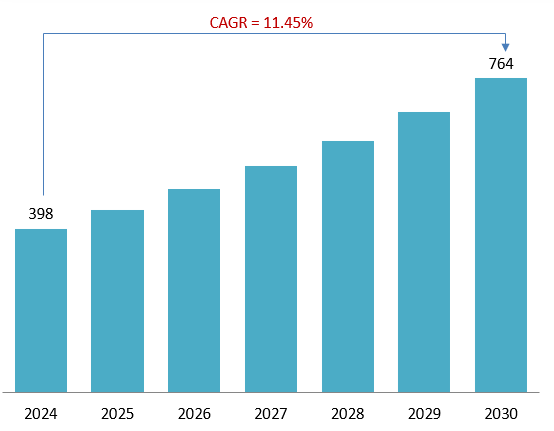
208월2025
최신 뉴스 및 보고서 / 베트남 브리핑
댓글: 댓글 없음.
베트남 디지털 헬스 시장은 2024년 3억 9,815만 달러 규모로 평가되었으며, 2030년까지 연평균 성장률 11.45%로 예측 기간 동안 견고한 성장을 보일 것으로 예상됩니다. [1] 이러한 성장은 특히 공공 병원의 과밀화와 더 나은 의료 서비스에 대한 국민들의 욕구 증가로 인한 의료 서비스 수요 증가에 힘입은 것입니다.
OECD에 따르면, 디지털 헬스케어는 원격진료, 인공지능(AI), 빅데이터, 기타 ICT 도구와 같은 디지털 기술을 적용하여 의료 시스템과 의료 서비스 제공을 지원하고 강화하는 것을 의미합니다. 디지털 헬스케어는 효율성, 접근성, 그리고 건강 결과를 개선할 수 있는 중요한 기회를 제공합니다. [2]
디지털 건강 시장 2024~2030
원천: TechSci 연구
정부 지원
베트남 정부는 디지털 헬스를 규제하는 데 그치지 않고 디지털 헬스의 발전에 적극적으로 참여하고 있습니다. 국가 디지털 전환 프로그램 (결정 749/QĐ-TTg)에 따라 의료는 최우선 분야로 지정되었습니다. 주요 추진 과제는 다음과 같습니다.
– 의무적 EHR 도입: 모든 의료 서비스 제공자는 2025년에서 2026년까지 전자 건강 기록(EHR)을 도입해야 하며, 이는 의료 IT 솔루션에 대한 막대한 B2B 수요를 창출합니다. 이러한 기록은 AI 진단 및 개인 맞춤 의료와 같은 미래 디지털 서비스의 데이터 기반을 형성합니다.
– VNeID 통합: EHR을 국가 디지털 ID 시스템(VNeID)에 연결하면 거의 1억 명에 달하는 시민의 건강 기록이 통합되어 데이터 기반 의료에 엄청난 잠재력이 발휘됩니다.
– 원격 진료 인프라: 국가 주도의 이니셔티브를 통해 1,000개 이상의 병원과 진료소가 원격진료를 통해 연결되어 중앙 병원의 혼잡을 완화하고 원격 진료가 가능해졌습니다.
– 정책 및 자금 지원: 정부는 의료 디지털화를 빠르게 추진하기 위해 상당한 자금(예: 30조 VND 또는 약 12억 6천만 달러)을 투자하기로 약속했습니다.
핵심 시장 세그먼트: 베트남 디지털 건강의 기둥
베트남의 디지털 헬스케어 환경은 여러 핵심 세그먼트로 구성되어 있으며, 각 세그먼트는 고유한 기술적 접근 방식을 통해 다양한 의료 요구를 충족합니다. 원격 진료부터 AI 기반 진단까지, 이러한 세그먼트는 빠르게 발전하는 산업의 핵심 축을 형성합니다. 아래 표는 주요 세그먼트, 기능, 그리고 시장 전반의 혁신과 도입을 주도하는 주요 업체를 간략하게 보여줍니다.
| 분절 | 설명 | 주목할 만한 인물/예시 |
| 원격진료/원격진료 | 원격 진료 및 만성 질환 모니터링 | 지오헬스, 메드247, 이닥터 |
| mHealth(모바일 헬스) | 건강/피트니스 앱, 약물 추적, 웨어러블 기기 | 지오헬스, 메드247, 이닥터, 애플리케이션
FPT 롱쩌우 / 약국 |
| 건강 IT 시스템(EHR/EMR/HIS) | 전자 건강 기록, 전자 의료 기록, 병원 IT 시스템 | FPT.eHospital, 비에텔-HIS, DrAid™ |
| 전자 약국 | 의약품 주문 및 배송을 위한 온라인 플랫폼 | 바이메드, FPT 롱쩌우, 약국 |
| AI 및 정밀 의학 | AI 기반 진단, 유전체 검사, 개인맞춤형 의학 | 빈브레인, 진 솔루션, 제네티카 |
출처: B&Company 편집
베트남의 여러 플랫폼은 다양한 사용자 요구를 충족하기 위해 여러 기능을 결합하여 통합 디지털 헬스 생태계로 발전했습니다. 주요 사례는 다음과 같습니다.
– 지오헬스: 원격진료, 가정방문의료, 전자건강기록관리, 온라인약품주문 등 원스톱 솔루션을 제공합니다.
– 이닥터: 모바일 앱을 통해 원격 상담, 개인 건강 기록 추적, 재택 검사 및 건강 모니터링을 제공합니다.
– 메드247: 원격 진료, 진료 예약, 만성 질환 관리, 약물 복용 알림 등의 기능을 갖춘 실제 진료소와 디지털 플랫폼을 운영합니다.
– FPT 롱쩌우: 소매 약국 체인을 넘어 이 플랫폼은 온라인 약물 구매, 약사 상담, 처방 관리, 의료 서비스 연계 등을 지원합니다.
성장 촉매: 베트남 디지털 건강 혁명에서 기회를 창출하는 요인
베트남의 독특한 인구학적 특성은 디지털 헬스 솔루션에 대한 장기적인 구조적 수요와 단기적인 소비자 수요를 모두 견인하고 있습니다. 한편, 베트남은 급속한 고령화 사회로 진입하고 있습니다. 2050년까지 전체 인구의 25% 이상이 60세 이상이며, 당뇨병, 고혈압, 암과 같은 만성 비전염성 질환(NCD)의 급격한 증가가 동반될 것으로 예상됩니다. [4] 급성 질환과 달리, NCD는 지속적인 관리, 정기적인 모니터링, 그리고 환자의 적극적인 참여가 필요하며, 이는 디지털 도구와 완벽하게 부합합니다. 이러한 요구는 원격 환자 모니터링, AI 기반 노인 케어, 만성 질환 관리 플랫폼과 같은 기술에 대한 지속적인 수요를 창출하고 있습니다.
동시에 베트남은 15~64세 인구가 70%(300만 명)에 달하고 34세 미만 인구가 거의 절반에 달하는 "황금 인구 구조"의 혜택을 누리고 있습니다. [4] 이러한 디지털 네이티브 세대는 높은 스마트폰 보급률(84% 이상)과 도시화 증가에 힘입어 모바일 건강 앱, 온라인 진료, 피트니스 플랫폼, 웨어러블 기기에 대한 강력한 단기 수요를 주도하고 있습니다. [5] 이처럼 기술에 정통한 젊고 기술에 익숙한 인구는 모바일 건강(mHealth) 솔루션과 스마트 웨어러블 기기에 이상적인 고객 기반입니다. 이러한 도구는 예방 관리 및 자가 모니터링으로의 전환을 지원하여 디지털 건강 시장에서 빠르게 성장하는 대규모 부문을 창출합니다.
이러한 성장세에 더해 베트남의 빠르게 성장하는 중산층과 가처분소득 증가도 영향을 미칩니다. 2035년까지 도시 중산층 소비자는 전체 인구의 50%를 차지할 것으로 예상되며, 이는 과밀화된 공공 병원보다 고품질의 기술 기반 민간 의료 서비스에 대한 선호도가 뚜렷함을 보여줍니다[6]. 코로나19 팬데믹은 이러한 변화를 더욱 가속화하여 원격 진료 및 원격 진료가 일반화되는 동시에 편의성, 접근성, 개인 맞춤형 웰빙에 대한 기대치를 높였습니다. 그 결과, 현대 의료 소비자에게 맞춤화된 자가 모니터링 도구, 건강 추적 앱, 예방 관리 솔루션에 대한 수요가 빠르게 증가하고 있습니다.
디지털 헬스케어 도입의 과제
베트남의 디지털 헬스케어 관련 법률 및 규제 체계는 아직 초기 단계에 있고, 불완전하며, 때로는 모호하여 투자자와 서비스 제공자 모두에게 불확실성을 야기하고 있습니다. 2023년 의료 검사 및 치료에 관한 법률과 관련 지침(예: 원격 치료 가능 질환에 대한 시행령 30/2023/TT-BYT)은 원격 의료의 법적 기반을 마련하고 있습니다.[7] 그러나 책임, 업무 범위, 상환 메커니즘, 데이터 상호운용성 등 중요한 세부 사항은 여전히 불분명합니다.
– 환불 프레임워크 부족: 현재 베트남의 사회 건강 보험 시스템이나 민간 보험사에서는 원격진료 서비스에 대한 비용을 보상하는 데 대한 명확한 규정이 없으며, 이는 서비스 제공자가 대규모로 도입하는 데 큰 장벽이 되고 있습니다.
– 책임 및 라이센스 모호성: 의료 책임, 원격진료 서비스 제공자의 허가 요건, 그리고 국경 간 진료의 합법성 등에 대한 불확실성이 여전히 존재합니다. 이러한 규제의 모호성은 조기 도입자가 갑작스러운 정책 변화로 인해 규정을 준수하지 않거나 상업적으로 성공하지 못할 위험이 있는 "선점자 불이익"을 초래할 수 있습니다.
– 데이터 보안 및 개인정보 보호: 정부가 개인정보보호령(Decree 13/2023/NĐ-CP)을 발표했지만, 그 조항은 여전히 광범위하고 해석의 여지가 있습니다.[8] 또한, 사이버보안법에 따른 데이터 현지화 요건은 외국 기업에 상당한 규정 준수 부담과 운영 비용을 초래할 수 있습니다.
인간적 요소
가장 큰 과제 중 하나는 다음과 같습니다. 환자의 신뢰와 행동특히 고령자와 농촌 지역 거주자들 사이에서 그렇습니다. 많은 환자들이 여전히 전통적인 대면 진료를 선호하며, 더 신뢰할 수 있고 개인적인 경험을 제공한다고 생각합니다. 따라서 가상 진단과 디지털 플랫폼에 대한 신뢰를 구축하는 것은 지속적인 과제이며, 특히 디지털 리터러시가 낮은 지역에서는 더욱 그렇습니다.
공급자 측에서, 의료 전문가들의 변화에 대한 저항 또 다른 장벽입니다. 많은 임상의들이 기존 업무 흐름을 방해하는 새로운 기술을 도입하는 것을 주저합니다. 법적 책임, 업무량 증가, 그리고 가상 진료의 한계에 대한 인식은 디지털 서비스 확장 의지를 약화시키는 경우가 많습니다.
그만큼 디지털 리터러시 격차 환자와 의료 서비스 제공자 모두에게 영향을 미치며, 특히 주요 도시 외곽 지역에서 더욱 그렇습니다. 포용적인 도입을 위해서는 교육, 훈련, 그리고 사용자 친화적인 플랫폼 설계에 대한 상당한 투자가 필수적입니다. 이러한 노력이 없다면 디지털 헬스케어는 인구의 상당 부분을 소외시킬 위험이 있습니다.
마지막으로, 데이터 개인정보 보호 문제 여전히 중요한 장애물로 남아 있습니다. 소비자와 서비스 제공자 모두 명확하고 투명한 사이버 보안 프로토콜과 강력한 데이터 보호 문화가 부재한 상황에서 eHealth 플랫폼을 온전히 도입하기를 꺼립니다. 개인 건강 데이터의 안전에 대한 신뢰는 확장 가능한 모든 디지털 의료 시스템의 근간입니다.
결론
베트남의 e헬스 시장은 정부 정책, 인구 통계학적 추세, 그리고 접근성이 높고 고품질의 의료 서비스에 대한 수요 증가에 힘입어 강력한 성장 잠재력을 보유하고 있습니다. 그러나 규제 격차, 제한된 보험금 지급 방식, 디지털 리터러시 장벽, 그리고 가상 진료에 대한 낮은 신뢰도와 같은 과제들을 해결해야 합니다. 이러한 난관을 극복하는 것이 진정으로 확장 가능하고 포용적인 디지털 헬스 생태계를 구축하는 데 핵심적인 역할을 할 것입니다.
[1] TechSci Research, 베트남 eHealth 시장입장>
[2] OECD, 디지털 헬스입장>
[3] 결정 749/QĐ-TTg입장>
[4] 공산주의 뉴스, 인구 고령화와 오늘날 지속 가능한 개발에 미치는 영향 - 베트남에 대한 정책적 함의입장>
[5] Tien Phong, 럭셔리에서 주류로: 베트남 사회의 모든 계층을 위한 스마트폰 혁명입장>
[6] 세계은행, 베트남 일반 보고서 2035입장>
[7] 회람 30/2023/TT-BYT입장>
[8] 법령 13/2023/NĐ-CP입장>
비앤컴퍼니
2008년부터 베트남에서 시장 조사를 전문으로 하는 최초의 일본 기업입니다. 업계 보고서, 업계 인터뷰, 소비자 설문 조사, 비즈니스 매칭을 포함한 광범위한 서비스를 제공합니다. 또한, 최근 베트남에서 900,000개 이상의 기업에 대한 데이터베이스를 개발하여 파트너를 검색하고 시장을 분석하는 데 사용할 수 있습니다.
문의사항이 있으시면 언제든지 문의해주세요.
info@b-company.jp + (84) 28 3910 3913
































